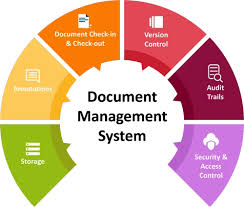
The Power of Document Management Systems in Modern Businesses
In today’s digital age, the volume of documents and data that businesses generate and handle on a daily basis is staggering. From invoices and contracts to reports and emails, managing this information efficiently is crucial for productivity, compliance, and overall success. This is where document management systems (DMS) come into play.
A document management system is a software solution that allows organizations to capture, store, manage, track, and share electronic documents and images. By centralizing document storage and providing robust search capabilities, DMS streamline workflows, improve collaboration, enhance security, and ensure regulatory compliance.
Key Benefits of Document Management Systems:
- Efficient Document Storage: DMS eliminate the need for physical file cabinets by storing documents electronically in a secure repository. This not only saves physical space but also makes it easier to organize and retrieve documents.
- Enhanced Searchability: With powerful search functionalities, users can quickly locate specific documents by entering keywords or metadata tags. This reduces the time spent searching for information and improves overall productivity.
- Version Control: DMS maintain a complete history of document revisions and updates, allowing users to track changes, revert to previous versions if needed, and ensure that everyone is working with the latest version of a document.
- Improved Collaboration: By providing secure access to documents from anywhere at any time, DMS facilitate collaboration among team members working remotely or across different locations. Real-time editing features further enhance teamwork efficiency.
- Security and Compliance: DMS offer robust security measures such as user permissions, encryption, audit trails, and automated backups to protect sensitive information from unauthorized access or loss. They also help organizations comply with data protection regulations.
Conclusion
Document management systems have become indispensable tools for modern businesses looking to streamline their document-related processes, boost efficiency, foster collaboration, and ensure data security. By investing in a reliable DMS tailored to their specific needs, organizations can unlock the full potential of their digital assets and stay ahead in today’s competitive landscape.
Top FAQs About Document Management Systems: Examples, Best Options, Uses, and Definitions
- What is an example of a document management system?
- Which is the best document management system?
- What is DMS used for?
- What is meant by document management system?
What is an example of a document management system?
An example of a popular document management system is Microsoft SharePoint. SharePoint is a versatile platform that offers robust document storage, collaboration tools, version control, and integration with other Microsoft Office applications. It allows users to create, store, organize, and share documents securely within a centralized environment. With features such as metadata tagging, workflow automation, and access control, SharePoint empowers organizations to effectively manage their documents and streamline their business processes.
Which is the best document management system?
When it comes to the question of which is the best document management system, the answer largely depends on the specific needs and requirements of an organization. There is no one-size-fits-all solution, as different businesses have varying priorities such as scalability, integration capabilities, user-friendliness, security features, and budget constraints. It is essential for businesses to conduct a thorough assessment of their document management needs and objectives before selecting a DMS. By evaluating factors like industry compliance requirements, team collaboration needs, data volume, and desired functionalities, organizations can identify the document management system that aligns most closely with their unique workflow and business goals.
What is DMS used for?
A Document Management System (DMS) is primarily used to streamline the storage, organization, retrieval, and sharing of electronic documents within an organization. By centralizing document storage in a secure digital repository, DMS enable users to easily access and manage files, collaborate with team members, track document versions, ensure regulatory compliance, and enhance overall productivity. DMS play a crucial role in eliminating manual document handling processes, reducing paper-based inefficiencies, improving searchability, and enhancing data security within businesses of all sizes and industries.
What is meant by document management system?
A document management system (DMS) refers to a software solution designed to efficiently capture, store, organize, manage, and retrieve electronic documents and images within an organization. By centralizing document storage and providing robust search and collaboration features, a DMS helps streamline workflows, improve productivity, enhance data security, ensure regulatory compliance, and facilitate seamless access to critical information for users across different departments or locations. In essence, a document management system acts as a digital repository that empowers businesses to effectively manage their documents throughout their lifecycle while optimizing processes and fostering collaboration among team members.
